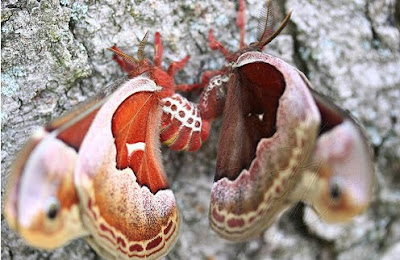 photo by natural born hikers
photo by natural born hikersEugene S. Morton
The American Midland Naturalist Jul 2009 : Vol. 162, Issue 1, pg(s) 7-18 doi: 10.1674/0003-0031-162.1.7
作者在半自然的條件下對普羅大蠶蛾(Callosamia promethea)與鵝掌楸蠶蛾(C. angulifera) 進行一妻多夫現象之比較。普羅大蠶蛾是天蠶蛾科中首先被文獻描述具有一妻多夫制的種類,而鵝掌楸蠶蛾則是一夫制的。實驗顯示一妻多夫和一妻一夫的普羅大蠶蛾雌性可達到近似的卵受精率,但是多夫的雌性能多產下10%的卵,具有顯著的差異。這些差異是從同一棵寄主植物上取食的五個普羅大蠶蛾手足群體中發現的。一妻多夫的普羅大蠶蛾具有的較高生殖力與雌性的體型、交配持續時間、卵的大小或數量、產卵的天數或屬於何手足群體均沒有關連。所有的雌性在產卵期尾聲時的卵尺寸均較小,體型小的雌蛾在產卵期中較早產下多量的卵。分別的標記再捕捉法研究顯示雄性的普羅大蠶蛾也交配多次(一夫多妻)、且在擇偶偏好上喜好未交配過的處女蛾。日間交配的普羅大蠶蛾可能可增加遺傳多樣性 與/和 由多夫制中得到來自精液的贈與。夜行性的天蠶蛾科物種均為一夫制,可能導因於產卵與交配兩者的時間衝突凌駕於多夫制的好處之上。若多夫制可增加繁殖力,則可推測在其他的日行性天蠶蛾中也會發生。
Abstract
Promethea (Callosamia promethea) and tulip tree silk moths (C. angulifera) were compared under semi-natural conditions for the presence of polyandry. Promethea were polyandrous, the first documentation for a saturniid moth, whereas tulip tree moths were monandrous. Experiments showed that polyandrous and monandrous promethea females achieved similar egg fertility, but polyandrous females laid 10% more eggs, a significant difference (P < 0.05). This difference was found in five sibling groups, whose larvae were reared on the same individual food plant. Higher fecundity for polyandrous promethea females was not related to female size, duration of copulation, egg size and number, number of days in laying period or sibling group. Egg size declined later in the laying period for all females. Small females laid more eggs earlier in the laying period than large females. A separate mark/recapture study showed that male promethea also mate multiple times (polygyny) and distinguish virgin from nonvirgin females in mating preference. The diurnally mating promethea may gain increased genetic variability and/or possibly seminal gifts from polyandry. Monandry in totally nocturnal saturniid moths may result from a time conflict between egg laying and mating, which overrides the benefits of polyandry. If polyandry increases fecundity, it is predicted to occur in other diurnally mating saturniids.
Received: March 3, 2008; Accepted: April 21, 2008
Abstract
Promethea (Callosamia promethea) and tulip tree silk moths (C. angulifera) were compared under semi-natural conditions for the presence of polyandry. Promethea were polyandrous, the first documentation for a saturniid moth, whereas tulip tree moths were monandrous. Experiments showed that polyandrous and monandrous promethea females achieved similar egg fertility, but polyandrous females laid 10% more eggs, a significant difference (P < 0.05). This difference was found in five sibling groups, whose larvae were reared on the same individual food plant. Higher fecundity for polyandrous promethea females was not related to female size, duration of copulation, egg size and number, number of days in laying period or sibling group. Egg size declined later in the laying period for all females. Small females laid more eggs earlier in the laying period than large females. A separate mark/recapture study showed that male promethea also mate multiple times (polygyny) and distinguish virgin from nonvirgin females in mating preference. The diurnally mating promethea may gain increased genetic variability and/or possibly seminal gifts from polyandry. Monandry in totally nocturnal saturniid moths may result from a time conflict between egg laying and mating, which overrides the benefits of polyandry. If polyandry increases fecundity, it is predicted to occur in other diurnally mating saturniids.
Received: March 3, 2008; Accepted: April 21, 2008

沒有留言:
張貼留言